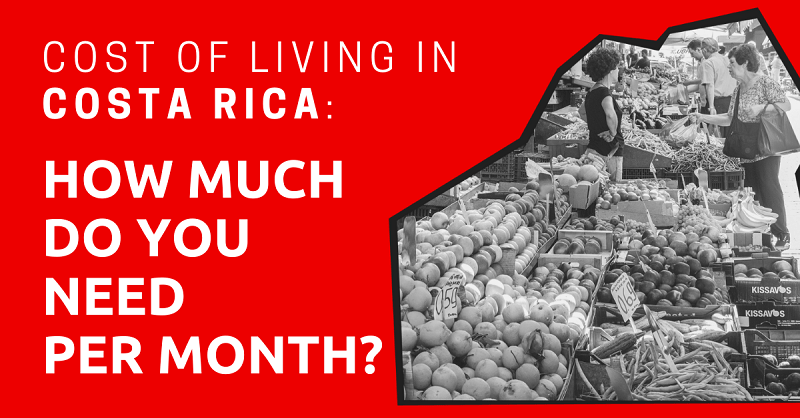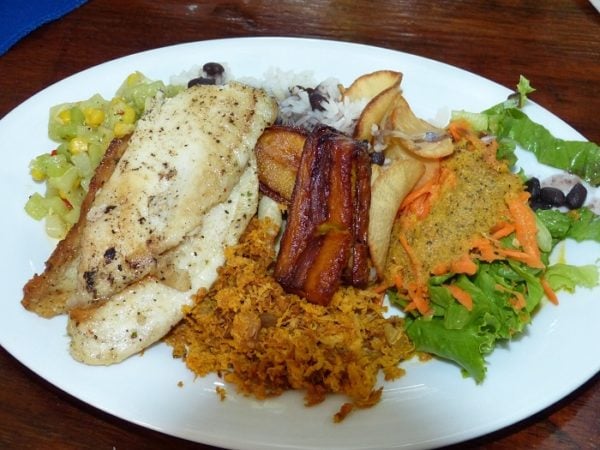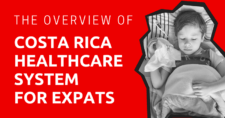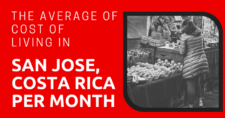
Whether you’re looking to retire in Costa Rica or spend a long time in the country, it helps to know the cost of living.
Not only will this help you budget how much you’re going to spend each month, but it’ll also help you save some cash so you can spend it on the things you enjoy in the country.
In this guide, we’re going to break down all the major and minor expenses you might incur each month while living in Costa Rica. From housing to food and from utilities to entertainment, let’s look at how expensive – or in most cases, inexpensive – Costa Rica is.
This article will take approximately 19 minutes to read. Don't have the time right now? No worries. You can email the ad-free version of the article to yourself and read it later!
Disclaimer: This article may include links to products or services offered by ExpatDen’s partners, which give us commissions when you click on them. Although this may influence how they appear in the text, we only recommend solutions that we would use in your situation. Read more in our Advertising Disclosure.
Contents
Key Takeaways
- The cost of living in Costa Rica is on average 26% lower than in the US.
- You can live a decent life for around US$1,000 per person.
- Not including conversion rates, your foreign money can stretch further in Costa Rica compared to your home country.
- Local products are very cheap, whereas imported goods are quite expensive due to taxes. However, it averages out in your favor.
- The type of visa you have and the length of time you plan to stay in the country can impact your cost of living because of the country healthcare system
Is it Cheap to Live in Costa Rica?
When it comes to living in Costa Rica, the first thing many expats want to know is if the country is expensive. The answer ultimately depends on your country of origin. If you’re from the US, UK, Canada, etc, the answer is no. If you’re from elsewhere in South America, the answer is yes.
Costa Rica is more expensive than any other Central American country. However, it’s noticeably cheaper than North American and European countries.
As of 2024, the cost of living in Costa Rica is 26% lower than in the US, according to Numbeo.
This means that if you’re an American national, you can expect the same standard of living in Costa Rica for 26% less than you’d pay in the US.
Some quick figures to build on this include:
- Rent is 62% lower in Costa Rica
- Groceries are 25.5% lower in Costa Rica
- A meal at McDonald’s is 8% lower in Costa Rica
- However, a gallon of milk is 75% more expensive in Costa Rica
On the other hand, local purchasing power is 68% lower in Costa Rica. In short, this means the same amount of money will get you 68% less in Costa Rica compared to the US.
This is primarily due to the country’s weaker currency as well as local taxes. But as shown in the figures above, non-natives will generally end up better off either way.
Let’s look at some examples of how things balance out through inexpensive local goods and expensive imports:
- Luxury items are expensive but basic-need items are cheap
- Imported goods are expensive but products made or grown in-country are cheap
- Gasoline is expensive but hiring labor is cheap
Importantly, buying non-local products can add a lot to the overall cost. For example, American branded shaving cream can cost around 5,000 colones (US$7.85). However, with a local brand, you pay no more than 1,600 colones (US$2.50).
Provided you’re happy to buy local brands (which are typically just as good), your money will go a lot further. But as we’ll explore below, there are plenty of ways to keep your cost of living down even more.
Visa Type
Your immigration status while living in Costa Rica will play a major role in your cost of living. When you move to Costa Rica, you have many visa options that will let you live here long-term.
They include being a retiree (pensionado), an inversionista (business owner or investor), a rentista (property owner), or the spouse of a Costa Rican.
When you get one of these statuses, you will experience cheaper living expenses because Costa Rica puts its people first – whether local or expat.
If you have your residency ID, you’ll be considered and recognized as one of the country’s own. You’ll get cheaper health care coverage and you’ll find it easier to qualify for rental leases.
With that said, getting a residency ID takes a lot of time and money and may not work out in your favor if you only plan to stay in Costa Rica on a 90-day tourist visa.
For everyone else, keep reading.
Housing Prices
Housing prices in Costa Rica depend on the same circumstances you would find in other countries.
Prices are based on whether you want to live in low class, middle class, or upper class neighborhoods and depend on amenities, location, and total square meters.
Living a modest life here is possible, though, so it shouldn’t come as a surprise to hear that housing prices in Costa Rica are so low compared to the West.
In fact, you can buy a two-bedroom condo for under 63,730,220.00 colones (US$100,000). If you want luxury, then you will find it a lot more costly, up to 1,500,000,000 colones (US$2.35 million) in places like Guanacaste.
You can also find properties for as little as US$50,000 – US$75,000, although these may not align with the standard of living you’re after. Finally, you have the option to buy a piece of land and build your own house, which can be surprisingly affordable.
Short-Term Rentals
You can get a short-term rental to get a feel for living in Costa Rica before you commit to moving to the country. This will give you a little taste of what you can expect while living in Costa Rica long-term.
Many options for a short-term stay are available, such as:
- Airbnb
- Hostels
- Hotels
If you decide to stay in an Airbnb, hostel, or hotel, you can look for other convenient short-term options while inside the country.
You can easily walk around the barrios (neighborhoods) and find signs that say se alquila (for rent) hanging in the home’s window.
Going directly through an owner is the easiest way to land a rental.
Depending on the size of the rental and utilities, the average short-term rental is between 160,000 to 380,000 colones (US$300 to US$750) per month.
Long-Term Rentals
Finding long-term apartments or rental homes is easy, and once you sign a lease, you’ll be locked into an agreed upon monthly amount that can either include or exclude utilities.
Either way, the monthly rent can range from 130,000 to 2.5 million colones (US$250 to US$5,000) per month, depending on the region you decide to live in.
Food
The diet of Costa Ricans is made up of rice and beans, which will always be included in a typical meal.

A mid-range, 3-course meal will set you back around 30,000 colones ($58), which is 22% less than the equivalent in the US.
This is due to the control that the government has over the price of rice and beans, which is relatively cheap and affordable for ticos, or Costa Rican natives.
Rice is a staple of Costa Rican cuisine, so if you want to live like a local (or live inexpensively), you better get used to it!
A pound of rice costs around 500 colones ($1), making it a great dietary staple.
Because of cheap food prices, you can make one grocery run and have an entire month’s worth of food for under 130,000 colones (US$250).
If you live in areas frequented by expats, then you may see higher prices. Asking around to find the lowest prices is a good idea because locals know where to go.
Generally, you’ll find everything you need at your local supermarket. Areas with large expat populations typically have more organic and artisanal grocery stores, where prices are higher.
To save the most on your grocery bill, visit the weekly farmer’s market in your area. They’re a good way to familiarize yourself with local, seasonal produce, and you can often save a bit of money if you can haggle (in Spanish, of course!).
Farmers’ Markets
Like we’ve mentioned, getting your produce from the local farmers’ market is the way to go. Not only will you get an entire month’s worth of produce for under US$120, but you can find them in every city.
You can buy yuca chips (cassava chips) at farmers’ markets.
Normally, farmers’ markets are held on Friday and Saturday mornings and provide the freshest fruits and vegetables straight from the farm.
Oftentimes, you will find vegetables that are hard to find in the states, such as yuca, which is like a potato.
You can buy yuca chips (cassava chips) at farmers’ markets.
Some of the popular farmers’ markets can be found in the following cities:
- Heredia: the Heredia farmers’ market is in front of the plaza in San Bartolome. It is a big farmers’ market.
- Alajuela: Alajuela’s farmers’ market is two blocks west from the Santa Anita gas station. You have your choice of going on a Friday or Saturday, but to get the best produce, go on Friday.
- Atena: the farmers’ market in Atena is held on Friday and can be found south of the central market.
- Escazu: this suburb is well-known for many wealthy ticos. Its farmers’ market is held every Saturday near the central Catholic Church.
- Jaco: the Jaco farmers’ market is held every Saturday and is near the stadium.
- La Fortuna – The farmers’ market in La Fortuna can be found every Friday near the city’s Salon Comunal de La Fortuna, which is close to the volcano.
Dining Out
There will be many times that you don’t feel like cooking at home and decide to dine out. Luckily, there’s loads of great local cuisine to discover in Costa Rica, and prices are very reasonable.
There are many restaurants that serve everything from cheap traditional food to porterhouse steaks that will run you at least 30,000 colones (US$58).
But, if you want to truly experience Costa Rican food, keep an eye out for the local sodas, or diner.
A plate of local food with meat costs around 5,000 colones (US$10). A meal can even be as cheap as 2,500 colones (US$5) in non-touristy areas.
These are family-owned and serve traditional meals that may have a little twist to them. However, they will normally have rice and beans in the mix and are inexpensive.
A typical meal at a soda includes salchichon – or sausage – eggs, a cheese slice, and pinto beans.
If you add in a natural drink, then that will only be an extra 500 colones (US$0.75-1). So, in total, a traditional meal will run you about $11.
Taxis
There are two types of official taxi services in Costa Rica: red and orange.
You will only find orange taxs at the airport and they primarily transport passengers to their destinations.
Their meter begins at 960 colones (US$1.87) and increases in 10 colones intervals until you reach your destination.
You will find the more common red taxis in all provinces, and they can only pick up passengers in their designated areas.
The meter rate for red taxis begins at 660 colones (US$1.28) and every km thereafter is 630 colones (US$1.23). So if you take a red taxi to a destination 10 km away you can expect to pay 660 + 630×10 km = 6960 colones (US$13.50).
Other than the official taxis Uber also operates and employs close to 30,000 Costa Ricans since launching in 2015. It services all areas of the country.
The cost for an Uber ride also varies but tends to be cheaper than taxis. The average price is roughly 3,100 colones (US$6) in the San Jose area.
Transportation
Having a new car in Costa Rica is expensive. The difference in price can be 28% more or greater than the equivalent vehicle in the US. Also, as mentioned, gasoline is very expensive (55% more per gallon than the US).Public transportation in Costa Rica, on the other hand, is very affordable.
Buses are available for almost every destination within Costa Rica. Not only that, but public transportation is as easy to use as those in other developed countries.
Every bus route is cheap by comparison, but like everything else, the price depends on the distance of your destination. So, the further away you go, the more you will pay.
Currently, the price for a local city bus is typically about 500 colones (around US$1).
Besides local buses, there are also buses that travel to further distances, which originate in San Jose and have bus terminals in smaller cities.
Like we’ve mentioned, the price depends on the distance and can vary between 1,500 and 6,400 colones (US$3 and US$12.50).
The more popular destinations that the San Jose bus routes cover include the following:
- Poas Volcano = 3,100 colones (US$6.00)
- Tamarindo = 5,700 colones (US$11.00)
- Manuel Antonio = 4,400 colones (US$8.50)
- Quepos = 3,800 colones (US$7.40)
- Playas del Coco = 6,400 colones (US$12.50)
Public Healthcare Services
Costa Rica provides a universal health system through CCSS (CAJA) and private healthcare insurance through their Instituto de Seguro Nacional (INS).
The health services provided through CAJA are paid for through a percentage of your monthly salary. The rates increased in 2022, so those enrolling in the program after March of 2022 will pay higher rates.
The percentage you pay depends on your total monthly income, but it ranges between 9-17% for foreigners and also depends on your official status in Costa Rica. The INS is a little different in that its costs are determined by age.
- Up to 21 years old: 18,000 colones (US$35)
- 22 to 40 years old: 24,000 colones (US$46)
- 40 to 60 years old: 33,000 colones (US$64)
- 60 and above: 42,000 colones (US$81)
The healthcare and dental care provided in Costa Rica are among the best in the world in regard to costs and quality.
Like we said above, all healthcare recipients must pay a certain monthly amount in order to receive care. The payments are minimal, which is great for the quality of care you can receive.
As soon as you’re all set up and current with payments, you’ll have access to free services that you would normally have to pay for out of pocket in the US, especially prescriptions.
Regardless of being able to provide superior care, public hospitals are often crowded with patients who don’t have a choice over the doctor that sees them.
Education
If you have school-aged children and they have some level of Spanish, then you may be able to enroll them into public school.
If they do, then you can expect to pay for supplies, uniforms, and books. You don’t have to worry about the cost, however, because at the most, it will be no more than 13,000 colones (US$25).
If you prefer to have your child attend an international or private school, then you’re looking at tuition on top of the normal supplies and requirements.
Having your child receive a private education will cost you quite a bit depending on the age of your child and which school they go to.
On average, monthly tuition for basic private schools start at 130,000 colones (US$250.00) and can go as high as 1.3 million colones (US$2,500)for more prestigious academies.
As for international schools, the yearly price is the same across the board and can be as high as 9 million colones (US$17,500).
Attending university in Costa Rica is another option once you make Costa Rica your home. The yearly tuition ranges between 1.5 million colones (US$2,900) and 1.7 million colones (US$3,300) for a public university undergraduate degree. And up to 25 million colones (US$48,000) for a degree at a private institution.
If you wish to obtain your graduate degree, then you can expect a cost of at least 2.75 million colones (US$5,300).
Coffee
Coffee in Costa Rica is taken very seriously and is highly regulated by the government to ensure that only 100% Arabica quality is maintained.
Chances are, you will experience a nice cup of Joe while in Costa Rica and will want to keep a bag of your favorite ground beans in your house.
Costa Rica provides the best conditions for growing coffee. The soil is very rich and fertile, the climate is warm, and there is plenty of rain.
Because conditions are ideal, only 100% Arabica beans are grown.
Once you’ve lived in the country for a while and are invited into a friend’s home, you’ll notice that they will always offer you a cup of coffee.
Likewise, when you make plans to go out with friends, coffee will always be part of the date regardless of what the actual plans will be later.
Prices will vary based on brand, amount of ground coffee, and strength. But on average, a 200g bag of ground coffee costs roughly 1,500 colones (US$3).
If you go out for a coffee, you can expect to pay around 1,700 colones (around US$3.40) for an expensive cup. You’ll find far cheaper coffees at local bars.
Utilities
Electricity will cost you the most in terms of monthly utilities. Unsurprisingly, you’ll use your home’s air conditioning a lot if you live in a hot and humid area of Costa Rica.
If you decide to live in these areas, then you can expect the climate to be a constant 80 degrees with a humidity level that averages 85%.
In the central valley, though, the climate is cooler and more comfortable thanks to the mountainous surroundings that bring in the cool winds.
With that said, let’s take a look at a breakdown of each utility.
Electricity
Electricity is priced on a per-unit basis, the same as pretty much everywhere else. As such, you’ll pay more if you use more. Charges are calculated on a sliding scale based on how much you use.
As of 2023, some example figures are:
- Less than 3,000kWh: 54-134 colones per unit
- More than 3,000kWh: 49-106 colones per unit.
This works out to $0.09-$0.26US per unit. In comparison, the current average in the US is $0.17 per kWh. However, it can go as high as 28-42 cents per unit.
Rates also depend on housing type. You can check the CNFL website for more info.
Water
Water consumption is not an expensive utility in Costa Rica, but it is metered, so the amount you use has to be paid for.
On average, the cost for water is moderately cheap thanks in part to many home appliances that help to conserve water.
A few of these include washing machines that are semi-automatic and shower heads that are low-flow. You’ll rarely see a dishwasher in a home as dishes are mainly hand-washed.
With this in consideration, the average cost for water is around 8,000-15,000 colones (US$15 to US$29.00) per month.
You can check the Institute of Aqueducts and Sewers for a detailed breakdown of water price per unit.
Cable Television and Internet
The three main cable providers in Costa Rica are:
These cable providers offer customers at least 55 channels in both English and Spanish.
If you wish to include the internet with your cable, that is no problem and can be installed in one day.
On average, the cost for cable and internet depends on your needs, but can average between 15,000 to 32,000 colones (US$23 to US$50) per month.
It’s worth noting that you might have to pay a lot more in remote areas, though, especially where traditional cable might not be a viable option.
Here, satellite internet is probably your best bet, and this could set you back anywhere from US$100 to US$500 per month depending on the plan you choose.
Entertainment
Visiting and living in Costa Rica can be a fun experience and the country offers a lot of enjoyable activities.
National park entrance fees in Costa Rica are between 4,400 and 9,500 colones (US$8.50 and US$18.50) per person, per day.
From the beaches to the national parks, there’s something for everyone once you know where to look.
If you’re a nature and outdoor type, then making visits to the many national parks will help you to stay relaxed.
Many of the activities offered in national parks include touring through the canopies, observing the wildlife, riding horses, and hiking on the many trails.
There are also many trips that take an entire day, like visiting the active Poas Volcano or the La Fortuna Hot Springs.
Tour prices per person can be as much as 50,000 colones (US$97).
Average Cost of Living
When you decide to make Costa Rica your home, you will love that every city has a different cost of living, which makes it easy to live on a budget.
Below, we’ve listed the major cities and regions that U.S. expats love the most along with the average cost of living for a single person.
- San Jose: 700,000 colones (US$1,300)
- Alajuela: 575,000 colones (US$1,100)
- Limon/Puerto Viajo: 640,000 colones (US$1,250)
- Guanacasta: 1,270,000 colones (US$2,500)
- Puntarenas: 800,000 colones (US$1,500)
Now, on to You
The location and lifestyle that you’re after while living in Costa Rica will unsurprisingly influence the amount you spend each month.
However, when you factor in everything above, the average amount can be between 550,000 to 3,000,000 colones (US$1,000 and US$6,000) per month. It’s also worth factoring in that a couple will save a bit of money compared to two people living alone.
Considering everything you’ve discovered in this guide to the cost of living in Costa Rica, what would your monthly expenses be?








I love and I will be visiting soon hopefully for good.
I’m looking for the first time purse small place the one person don’t need very much I don’t know if I want to rent a townhouse or condo or buy a house it will be the first time I would like to live not in the city somewhere a little quiet may be near a beach I can step out and go swimming or laying in the Sun something something simple I just would like to know how much it will cost so live there transportation does not matter to me I can buy a scooter or take the bus or if you have a train I like to see the sights I like the waterfall an animals can you guys help me thank you